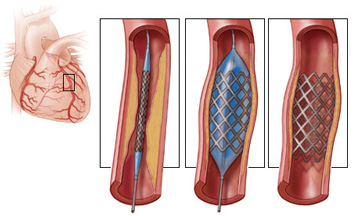Angioplasty and stenting
Definition of angioplasty
 Coronary angioplasty, also called percutaneous coronary intervention, is a procedure used to open clogged heart arteries. Angioplasty uses a small balloon catheter that is inserted into a blocked blood vessel to help widen it and improve blood flow to your heart.
Coronary angioplasty, also called percutaneous coronary intervention, is a procedure used to open clogged heart arteries. Angioplasty uses a small balloon catheter that is inserted into a blocked blood vessel to help widen it and improve blood flow to your heart.
Angioplasty is often combined with the placement of a small wire mesh tube called a stent. The stent helps keep the artery open, which decreases its chances of narrowing again. Most stents are coated with drugs to help keep your artery open (drug-eluting stents). Rarely, bare metal stents can be used.
Angioplasty can improve symptoms of blocked arteries, such as chest pain and shortness of breath. Angioplasty is also often used during a heart attack to quickly open a blocked artery and reduce the amount of damage to your heart.
Why place a stent?
Angioplasty is used to treat fatty plaque buildup in the blood vessels of your heart. This buildup is a type of heart disease known as atherosclerosis.
Angioplasty may be a treatment option for you if:
You have tried medications or lifestyle changes, but these have not improved your heart health.
You have chest pain that is getting worse.
You have a heart attack. Angioplasty can quickly open a blocked artery, reducing damage to your heart.
Angioplasty is not for everyone. Depending on the extent of your heart disease and your general health, your doctor may determine that bypass surgery is a better option than angioplasty for you.
You may need coronary artery bypass surgery if:
The main artery that brings blood to the left side of your heart is narrow.
Your heart muscle is weak.
You have diabetes and multiple severe blockages in your arteries.
During a coronary artery bypass, the blocked part of your artery is bypassed using a healthy blood vessel from another part of your body.
How to prepare for an angioplasty?
Before a scheduled angioplasty, your doctor will review your medical history and perform a physical exam. You may need to have routine tests, including a chest x-ray, electrocardiogram, and blood tests, before your procedure. Your doctor will also do an imaging test called coronary angiography to see if the arteries in your heart are blocked and can be treated with angioplasty.
If your doctor discovers a blockage during your coronary angiogram, they may decide to perform angioplasty and stenting immediately after the angiogram while your heart is still catheterized.
Your doctor may want you to adjust or stop taking certain medications before the angioplasty, such as aspirin, nonsteroidal anti-inflammatory drugs (NSAIDs), or blood thinners. Be sure to tell your doctor about all medications you take, including herbal supplements.
Usually you will need to stop eating or drinking six to eight hours before an angiogram.
Take approved medications with only small sips of water the morning of your procedure.
Gather all your medications to take to the hospital with you, including nitroglycerin, if you take any.
Arrange transportation home. Angioplasty usually requires an overnight stay in the hospital and you won't be able to drive home the next day.
Placement of the stent
Most people who have angioplasty also have a stent placed in their blocked artery during the same procedure. A stent, which looks like a tiny coil of wire mesh, supports the walls of your artery and helps keep it from narrowing after angioplasty.
This is what happens when a stent is placed:
The stent, which is folded around a balloon at the end of the catheter, is guided through the artery until blocked.
At the blockage, the balloon is inflated and the spring-like stent expands and locks into place inside the artery.
The stent stays in the artery all the time to keep it open and improve blood flow to your heart. In some cases, more than one stent may be needed to open a blockage.
Once the stent is in place, the balloon catheter is deflated and removed.
More x-ray pictures (angiograms) are taken to see how well blood is flowing through your newly widened artery.
Most stents implanted during angioplasty are coated with medication. The drug in the stent is released slowly to help prevent future plaque buildup and narrowing of the blood vessel.
After your stent has been placed, your doctor will prescribe medications such as aspirin, clopidogrel (Plavix), ticagrelor (Brilinta), or prasugrel (Effient), to reduce the risk of clots forming blood on the stent.
Results
Coronary angioplasty dramatically increases blood flow through the previously narrowed or blocked coronary artery. Your chest pain should generally decrease and you may be able to exercise better.
Having an angioplasty and a stent does not mean your heart disease will go away. You will need to maintain healthy lifestyle habits and take the medications prescribed by your doctor.